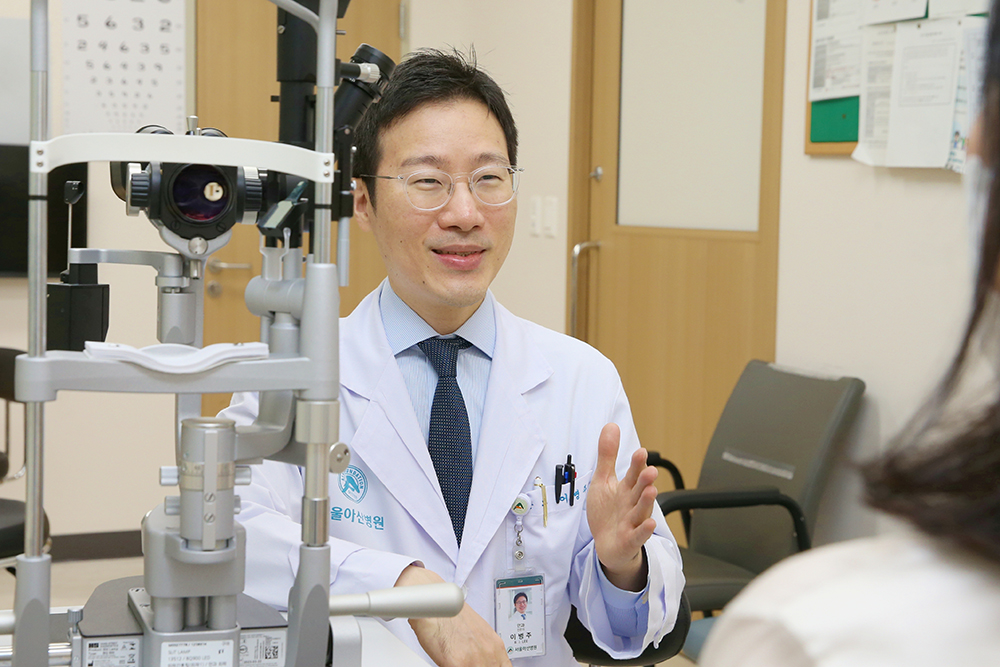-
- Global AMC MENU
- NEWS
- HEALTH
- PEOPLE
- Introduction

“It feels very uncomfortable, right?”
Professor Byung Joo Lee of the Department of Ophthalmology at Asan Medical Center often asks his patients this question. Understanding patients’ discomfort is the first step in treatment. Just as both eyes need to work in unison to view the world without discomfort or confusion, Professor Lee practices open communication in treating his patients so they can work toward the same treatment goals.
Treatment Starting from Dialogue
The eye is a substantially independent organ that contains many components within. Its functional complexity and mystery attracted Professor Lee to develop an interest in ophthalmology early on. He chose pediatric ophthalmology, particularly because it was heartbreaking that children experiencing visual development during their formative years may miss the opportunity to view the world properly. While treating strabismus, often occurring in childhood, he has expanded his practice into the field of the brain-nervous system that causes strabismus to provide neuro-ophthalmology treatment.
In his previous medical volunteer work in Africa, he performed strabismus surgery on a female patient in her twenties. Although the patient had severe strabismus since childhood, she had been left untreated without receiving medical care. After surgery, the patient was delighted and thanked him for changing her life, saying she could not get a job and marry. He said, “It was an experience that taught me to realize I was dealing with something other than subjective ‘beauty.’ Correcting the position of the eye objectively is essential to enhancing and improving one’s life.”
Patients' expectations sometimes encounter treatment limitations or differ from the clinician’s treatment goals. Professor Lee communicates with patients sufficiently to bridge this gap. “I first understand what patients want and their lifestyle patterns. Then, I explain the disease characteristics and treatment options, working together to find better options.” When surgery is decided, Professor Lee still ponders on the scope and method of operation. In many cases, the final decision is made just before surgery. This personality of not being able to make quick decisions is both an advantage and disadvantage. “The decision is not difficult for those undergoing surgery for the first time. However, patients with multiple recurrences and more complicated factors face increased limitations in treatment. I have to think harder because the next step should be best. That is also the role of Asan Medical Center. At the end of the day, decisions made after careful deliberation leave no regrets.”
A Heartfelt Concern Leading to Research
The development of various techniques, such as genetic testing, has made it possible to diagnose rare diseases for which it was previously unknown why one could not see or feel discomfort. We now have a better understanding of the diseases. However, it is very frustrating as a doctor when no answer is available for patients inquiring about treatment options. There is no room for intervention, especially when the disease has already progressed to optic nerve atrophy, which is the end stage of all optic nerve diseases. “While researching methods to protect the optic nerve, effects were observed in laboratory animals. However, the results were not satisfactory when applied to patients. This task should be addressed step by step, starting from basic research.” Professor Lee pursued a master’s course in molecular medicine and bio-pharmaceuticals because he wanted to create opportunities for basic experiments and build experience to discover new treatments for optic nerve diseases.
Recently, he has been involved in developing various digital therapeutics. One is a non-invasive treatment, complementing the shortcomings of existing treatment methods or preventive measures, which is a digital treatment developed in cooperation with Professor Dong-Wha Kang of the Department of Neurology that will enhance the ability of patients with strabismus to use both eyes together. Additionally, another digital therapy to suppress myopia progression is undergoing a clinical trial. Future studies will identify how to best utilize it in pediatric ophthalmology and which patients would benefit the most.
Empathizing with Patients’ Suffering
The first symptoms of various diseases often appear in the eyes. One patient who visited me due to exophthalmos and strabismus was diagnosed with an autoimmune disease called ‘thyroid eye disease.’ The patient had to endure discomfort for several years because surgery could be performed only after the disease had stopped progressing. The patient came to see Professor Lee carrying a small flower pot after finally undergoing surgery, with external problems and the inconvenience of seeing things split into two resolved. “The patient gave me an orchid grown at home as a gift, saying that it was really difficult to grow flowers. The pot conveyed the patient’s joy and gratitude, so I always keep it close to me and water it even now (laughs).”
In consulting his patients, Professor Lee looks forward to the moment when he can tell his patients, “You don’t have to meet me regularly anymore.” One of his happiest moments is when patients who are stuck in the dark, not knowing the cause of their eye problems, are referred to the correct medical department through appropriate examinations and diagnosis. “I hope patients who have received multiple treatments elsewhere or are in great discomfort can open their minds when they come to see me. I will try to become a doctor who listens to and empathizes with patients better so that they always feel comfortable.”












